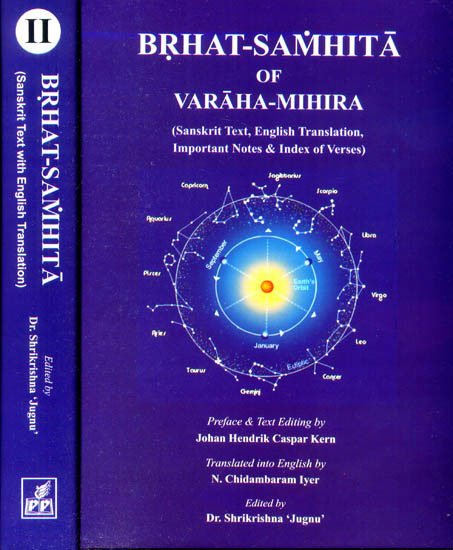Brihat Samhita
by N. Chidambaram Iyer | 1884 | 135,584 words | ISBN-13: 9788171104215
This page describes flowers and plants (kusumalata) which is the twenty-ninth Chapter of the English translation of the Brihat-samhita. This work, written by Varahamihira in the 6th century, is classified as jyotisha literature, also known as Indian astronomy. It contains however, also content regarding astrology, palmistry, agriculture, gardening, perfumes, medicines and various other encyclopedic topics.
Chapter 29 - On flowers and plants (kusumalatā)
[Sanskrit text for this chapter is available]
1. Judging from the growth of the fruits and flowers of trees and, plants we may determine beforehand what articles can be had cheap and in abundance and what crops will thrive.
2. If the Śāla[1] tree should bear fruits and flowers, Kalama (white rice) will grow in abundance; if the red Aśoka should bear fruits and flowers red paddy will grow; if the Kṣīrika should bear fruits and flowers white paddy will grow and if the black Aśoka should bear fruits and flowers black rice will grow.
3. The growth of the Nyagrodha (the Banyan tree) indicates the growth of Yava (barley); the growth of Tinduka indicates the growth of the Ṣaṣṭika rice; and the growth of the Aśvattha indicates the growth of all crops.
4. The growth of the Jambū (the rose apple) tree indicates the growth of the gingelly and black gram; the growth of Śirīṣa indicates the growth of the Kaṅgū; the growth of Madhūka indicates the growth of wheat and the growth of the Saptaparṇa indicates the growth of the barley.
5. The growth of Atimuktaka (mountain ebony) and that of Kunda (cassia) indicate the growth of Kapāsa (cotton), the growth of Asana indicates the growth of Sarṣapa (mustard (plant); the growth of Badarī (Jajube tree) indicates the growth of Kulattha, and the growth of Cirabilva indicates the growth of the Mudga.
6. If the Atasī (common flax), Vetasa (the ratan) and Palāśa trees should bear blossoms, Kodrava will thrive; if Tilaka should bear blossoms, conch-shells, pearls and silver can be had in abundance and if Iṅguda should bear blossoms; Śaṇa (hemp) will thrive.
7. The growth of Hasti Karṇa (castor oil tree) shows that elephants will thrive; that of Aśva Karṇa shows that horses will thrive; that of Pāṭala (trumpet flower) shows that cows will thrive and the growth of plantains shows that goats and sheep will thrive.
8. If the Campaka should bear blossoms, gold can be had in abundance; if the Bandhujīvaka should bear blossoms corals can be had in abundance, if Kuravaka should bear blossoms, diamonds can be had in abundance and if Nandikāvarta should bear blossoms, cat’s-eye (gem) can be had in abundance.
9. The growth of the Sindhuvāra indicates that pearls can be had in abundance; that of Kusumbha (Safflower) indicates that Kumkuma can be had in abundance, that of the red lotus indicates that rulers will prosper and that of the blue lotus indicates that ministers will prosper.
10. If Suvarṇapuṣpa (the globe amaranth) should blossom, merchants will prosper; if the lotus should blossom, the Brāhmins will prosper, if the white water-lily should blossom, priests will prosper; if Saugandhika (the blue lotus) should blossom, the commanders of armies will prosper and if the Arka plant should blossom, gold will become cheap.
11. If the mango should thrive well, there will be prosperity in the land; if Bhallāta (marking-nut plant) should thrive, there will be fear in the land; if the Pīlu tree should thrive there will be health in the land; If Khadira and Śamī should thrive, there will be famine in the land; and if the Arjuna tree should thrive there will be good rain.
12. If Picumanda (the nimb tree) and Nāgu should bear blossoms, there will be prosperity in the land; if Kapittha should bear blossoms, there will be storm; if Nicula (Hijjal) should bear blossoms there will be drought and if Kuṭaja should bear blossoms there will be disease in the land.
13. If Dūrvā (bent grass) or the Kuśa grass should blossom, sugar-cane will thrive; if Kovidāra should blossom there will be fear from destructive fires; and if Śyāmalatā should blossom, prostitutes will prosper.
14. There will be good rain in those countries where trees, shrubs and creepers grow luxuriantly with glossy leaves uninjured by worms, but if the leaves should be otherwise there will be little rain,
[Appendix 4: Glossary of Indian botanical terms]
Footnotes and references:
[1]:
For an explanation of these botanical terms, see glossary at the end of this chapter.
